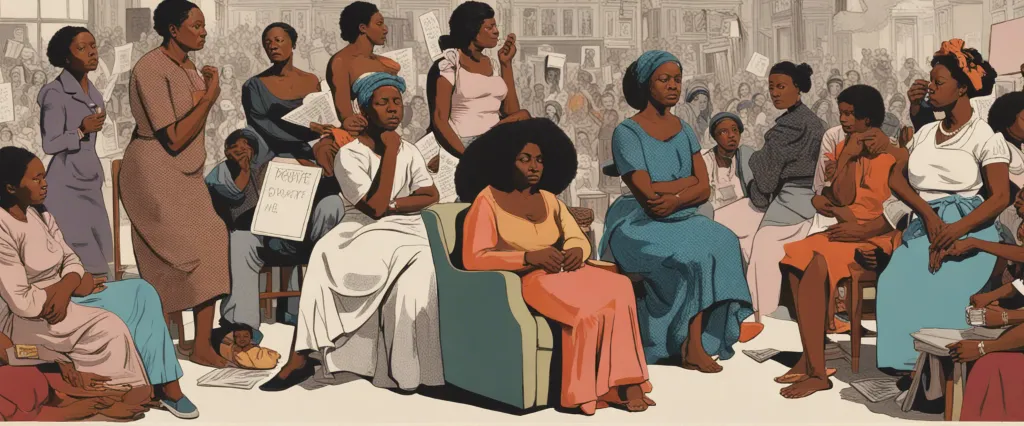
In examining the urgent and complex issue of gender inequality, numerous authors have bravely ventured into uncharted territories, shedding light on the multifaceted dimensions of women’s struggles around the world. Among these profound literary works are “Hood Feminism” by Mikki Kendall and “Half the Sky” by Nicholas D. Kristof. While both books tackle the deeply entrenched systems of oppression that hinder gender equality, they do so from remarkably distinct perspectives.
In “Hood Feminism,” Mikki Kendall shatters the notion of feminism as a privileged and exclusive movement, challenging readers to confront the inherent flaws within mainstream feminism. Through a compelling narrative, Kendall redirects our gaze towards the intersectionality of race, class, and gender, highlighting the vital importance of addressing the specific needs and experiences of marginalized women. With great acumen, she dissects the systemic issues plaguing minority communities, vividly portraying the inextricable links between issues such as poverty, food insecurity, and access to reproductive resources. Kendall’s work serves as an impassioned call to action, urging society to broaden its understanding of feminism and to embrace a more inclusive approach that uplifts the voices of all women.
On the other hand, Nicholas D. Kristof’s “Half the Sky” presents a meticulously researched account of the global struggle for women’s rights and empowerment. Traversing continents and delving into the lives of courageous women, Kristof explores the fundamental challenges faced by women in the developing world. His narrative paints a vivid picture of the interwoven obstacles of sex trafficking, maternal mortality, and gender-based violence, leaving an indelible impression on readers. Moreover, Kristof highlights the vital role that education, economic empowerment, and grassroots movements play in combatting these oppressive forces. By weaving together the stories of resilient women, he presents a compelling argument for why addressing gender inequality is not only a moral imperative but a prerequisite for progress and prosperity worldwide.
As we embark on this comparative study of two powerful literary works, it is important to acknowledge the unique lenses through which Mikki Kendall and Nicholas D. Kristof approach the fight for gender equality. “Hood Feminism” disrupts established narratives, emphasizing the urgency of intersectionality, while “Half the Sky” takes us on a globe-trotting journey, shedding light on the diverse struggles faced by women across continents. Through a comprehensive analysis of these books, we aim to explore the overlapping themes, disparities, and most importantly, the collective lessons that can be gleaned from their profound explorations of feminist thought and action.
Brief Summary of Two Books
Hood Feminism by Mikki Kendall
“Hood Feminism: Notes from the Women That a Movement Forgot” by Mikki Kendall is a thought-provoking and powerful book that highlights the intersectionality of feminism with race, class, and other social inequalities. The author argues that mainstream feminism often neglects the needs and experiences of women of color, low-income women, and those living in marginalized communities. Kendall explores various aspects of feminism, such as healthcare, education, employment, and domestic violence, and critiques the popular narrative that focuses solely on breaking glass ceilings and achieving equality for white, middle-class women. Instead, she emphasizes the importance of addressing systemic issues and making feminism inclusive and accessible to all. Kendall encourages readers to think beyond individual achievements and to actively work towards collective liberation. Overall, “Hood Feminism” challenges the narrow definition of feminism and offers a call to action for a more inclusive and impactful movement.
Half the Sky by Nicholas D. Kristof
“Half the Sky: Turning Oppression into Opportunity for Women Worldwide” is a book written by journalists Nicholas D. Kristof and Sheryl WuDunn. It focuses on the global issue of gender inequality and the oppression faced by women around the world. The book emphasizes that empowering women is not only morally right but also beneficial for societies.
The authors share stories of various women they have encountered, ranging from sex trafficking survivors in Cambodia to brave female activists in Africa. Through these narratives, Kristof and WuDunn aim to shed light on the interconnectedness of problems like violence, poverty, and lack of education that women face. They argue that addressing these issues and providing opportunities for women can lead to positive change and sustainable development.
The book explores various topics such as human trafficking, maternal mortality, gender-based violence, and the impact of discriminatory practices on women’s lives. It also discusses strategies and interventions that have shown promise in helping women rise above their circumstances, including education, microfinance, and healthcare initiatives.
Throughout the book, the authors make a compelling case for engaging individuals, governments, and organizations in the fight to improve women’s lives. They argue that by investing in women’s education, healthcare, and economic opportunities, societies can break the cycle of poverty and achieve progress.
“Half the Sky” serves as a wake-up call, urging readers to recognize the potential and resilience of women and to take action to ensure equal rights and opportunities for all. It highlights the vital role women play in shaping the future of their societies and emphasizes the urgency to address the challenges they face.
Comparison between Two Books

Similarities in Class
Both Hood Feminism by Mikki Kendall and Half the Sky by Nicholas D. Kristof discuss the issue of class as a fundamental aspect of feminism and women’s rights. They highlight the intersectionality of gender and class, emphasizing how poverty and social inequities affect women in unique ways.
In both books, the authors explore how poverty and lack of economic resources disproportionately impact women, particularly those from marginalized communities. They argue that addressing class disparities is crucial for achieving gender equality and uplifting all women.
Kendall’s Hood Feminism specifically focuses on the experiences of women of color and their unique challenges in regards to class. She critiques mainstream feminism for often overlooking the struggles faced by working-class and low-income women, arguing that true feminism must be inclusive and prioritize the needs of all women, regardless of their socioeconomic background. Kendall also highlights how economic inequalities intersect with other forms of oppression, such as racism and systemic bias.
Similarly, Kristof and WuDunn’s Half the Sky explores how poverty and lack of resources create barriers for women worldwide. They outline the connection between women’s economic empowerment and overall development, asserting that investing in women’s education and economic participation can have a significant impact on poverty reduction and social progress. The book features stories of women living in poverty who strive to improve their lives and the lives of their communities through entrepreneurship and education.
In sum, both books underline the significance of addressing class disparities as an essential component of feminist activism. They shed light on the specific challenges faced by women from low-income backgrounds and advocate for inclusive, intersectional approaches that uplift women across all classes.
Divergences in Class
Hood Feminism by Mikki Kendall and Half the Sky by Nicholas D. Kristof are two notable works that shed light on various aspects of women’s rights and gender inequality. While both books share a common goal of advocating for gender equality, they diverge in their treatment of class and its intersection with feminism.
Hood Feminism, as the title suggests, focuses on the experiences and struggles faced by marginalized women, especially those from low-income backgrounds. Mikki Kendall’s book highlights the importance of addressing the issues faced by women of color and women from impoverished communities. She argues that mainstream feminism often fails to adequately address the concerns of those who come from disadvantaged backgrounds due to the inherent biases and blind spots within feminist movements. Kendall delves into various topics, including reproductive justice, poverty, healthcare, and education, and emphasizes the significance of an inclusive feminism that recognizes class as a critical aspect of the struggle for gender equality. In Hood Feminism, class is a prominent theme and is examined in relation to race, highlighting how intersectionality plays a crucial role in understanding the complex experiences of women.
On the other hand, Half the Sky by Nicholas D. Kristof focuses more broadly on global issues facing women, including sex trafficking, maternal mortality, and lack of education. While the book acknowledges the barriers faced by women from different socio-economic backgrounds, it does not delve as deeply into class-specific challenges as Hood Feminism does. Kristof’s work tends to focus on issues that impact women on a global scale, often portraying them as victims and highlighting the need for external intervention to improve their lives. Although class inequalities are indirectly addressed in the book, they are not explicitly positioned as one of the main pillars of the feminist struggle, as Kendall does in Hood Feminism.
In summary, the divergence between Hood Feminism and Half the Sky lies in their treatment of class and its intersection with feminism. Hood Feminism actively recognizes and explores the impact of class on women, particularly those from low-income and marginalized communities. On the other hand, Half the Sky addresses global issues faced by women but does not explicitly prioritize examining class structures as an integral part of the feminist fight for gender equality. Both books contribute significantly to advocates for women’s rights, but they offer distinct perspectives on the role of class in the struggles and experiences of women around the world.

Conclusion
Both “Hood Feminism” by Mikki Kendall and “Half the Sky” by Nicholas D. Kristof are highly informative and thought-provoking books, but the one that is more worthy of reading depends on your interests and priorities.
“Hood Feminism” delves into the intersections of race, class, and gender in feminism. It sheds light on the ways in which mainstream feminism often fails to address the needs and experiences of marginalized women. Kendall’s book focuses on issues such as access to basic needs like food, housing, and healthcare, providing a critical perspective that is often missing from mainstream feminist discourse.
On the other hand, “Half the Sky” by Nicholas D. Kristof explores the oppression and struggles faced by women in developing countries worldwide. It showcases stories of resilience and highlights the urgency of addressing issues like sex trafficking, gender-based violence, and lack of access to education and can serve as a call to action for readers.
Considering the significance of both books, it might be worth considering your own interests and priorities. If you are interested in gaining a deeper understanding of feminist issues within Western societies, “Hood Feminism” could be more suitable for you. However, if you are passionate about global women’s rights and want to explore the challenges faced by marginalized women worldwide, “Half the Sky” might be the more appropriate choice.
Ultimately, both books offer valuable insights, contribute to important conversations about feminism, and are worthy of consideration.


